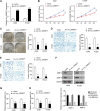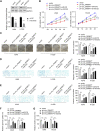CircRNA circ_0006677 Inhibits the Progression and Glycolysis in Non-Small-Cell Lung Cancer by Sponging miR-578 and Regulating SOCS2 Expression
- PMID: 34054537
- PMCID: PMC8155686
- DOI: 10.3389/fphar.2021.657053
CircRNA circ_0006677 Inhibits the Progression and Glycolysis in Non-Small-Cell Lung Cancer by Sponging miR-578 and Regulating SOCS2 Expression
Abstract
Objective: Circular RNAs (circRNAs) have been demonstrated in playing an important role in the physiological and pathological processes (such as cancer). This paper aims to clarify the role of Circ_0006677 in non-small-cell lung cancer (NSCLC) progression. Methods: Using clinical data and in vitro cell line models, we revealed the tumor-suppressive role of circ_0006677 in lung cancer. Using the online bioinformatics tool, we predicted the target of circ_0006677 and further validated its regulatory mechanisms responsible for its tumor suppressor function in NSCLC. Results: Circ_0006677 expression was reduced in NSCLC tissues of patients and lung cancer cells in comparison to adjacent normal tissues. Lower expression of circ_0006677 was significantly associated with poorer patient survival. Overexpression of circ_0006677 significantly inhibited the ability of NSCLC cell proliferation, migration, invasion, and glycolysis. Mechanically, circ_0006677 could inhibit NSCLC progression and glycolysis by regulating the expression of the signal transducer inhibitor SOSC2 through sponging microRNA-578 (miR-578). Conclusion: Circ_0006677 prevents the progression of NSCLC via modulating the miR-578/SOSC2 axis.
Keywords: SOSC2; circ_0006677; lung cancer; microRNA-578; non–small-cell lung cancer.
Copyright © 2021 Yang, Zhao, Yao, Zong and Xiao.
Conflict of interest statement
The authors declare that the research was conducted in the absence of any commercial or financial relationships that could be construed as a potential conflict of interest.
Figures







Similar articles
-
Downregulation of hsa_circ_0007580 inhibits non-small cell lung cancer tumorigenesis by reducing miR-545-3p sponging.Aging (Albany NY). 2020 Jul 18;12(14):14329-14340. doi: 10.18632/aging.103472. Epub 2020 Jul 18. Aging (Albany NY). 2020. PMID: 32681720 Free PMC article.
-
Circular RNA 0006349 Augments Glycolysis and Malignance of Non-small Cell Lung Cancer Cells Through the microRNA-98/MKP1 Axis.Front Cell Dev Biol. 2021 Sep 17;9:690307. doi: 10.3389/fcell.2021.690307. eCollection 2021. Front Cell Dev Biol. 2021. PMID: 34604211 Free PMC article.
-
Microarray Identifies a Key Carcinogenic Circular RNA 0008594 That Is Related to Non-Small-Cell Lung Cancer Development and Lymph Node Metastasis and Promotes NSCLC Progression by Regulating the miR-760-Mediated PI3K/AKT and MEK/ERK Pathways.Front Oncol. 2021 Nov 11;11:757541. doi: 10.3389/fonc.2021.757541. eCollection 2021. Front Oncol. 2021. PMID: 34858831 Free PMC article.
-
Circular RNA EPB41 expression predicts unfavorable prognoses in NSCLC by regulating miR-486-3p/eIF5A axis-mediated stemness.Cancer Cell Int. 2022 Jun 20;22(1):219. doi: 10.1186/s12935-022-02618-7. Cancer Cell Int. 2022. PMID: 35725615 Free PMC article.
-
Circular RNA circ-FOXM1 facilitates cell progression as ceRNA to target PPDPF and MACC1 by sponging miR-1304-5p in non-small cell lung cancer.Biochem Biophys Res Commun. 2019 May 21;513(1):207-212. doi: 10.1016/j.bbrc.2019.03.213. Epub 2019 Apr 4. Biochem Biophys Res Commun. 2019. PMID: 30954221
Cited by
-
CircGPC3 promotes hepatocellular carcinoma progression and metastasis by sponging miR-578 and regulating RAB7A/PSME3 expression.Sci Rep. 2024 Apr 1;14(1):7632. doi: 10.1038/s41598-024-58004-y. Sci Rep. 2024. PMID: 38561366 Free PMC article.
-
Comorbidity of hypertension and lung cancer: interplay of genetics and environment.Discov Oncol. 2025 Aug 13;16(1):1548. doi: 10.1007/s12672-025-03323-3. Discov Oncol. 2025. PMID: 40804226 Free PMC article. Review.
-
Hsa_circ_0006677 regulates special AT-rich binding protein-2-mediated tumor-suppressive effect via functioning as a miR-1245a sponge in non-small cell lung cancer.Bioengineered. 2022 Feb;13(2):3760-3774. doi: 10.1080/21655979.2022.2031400. Bioengineered. 2022. PMID: 35081869 Free PMC article.
-
Circular RNA hsa_circ_0018189 drives non-small cell lung cancer growth by sequestering miR-656-3p and enhancing xCT expression.J Clin Lab Anal. 2022 Nov;36(11):e24714. doi: 10.1002/jcla.24714. Epub 2022 Sep 26. J Clin Lab Anal. 2022. PMID: 36164726 Free PMC article.
-
Long non-coding RNAs in cancer: multifaceted roles and potential targets for immunotherapy.Mol Cell Biochem. 2024 Dec;479(12):3229-3254. doi: 10.1007/s11010-024-04933-1. Epub 2024 Feb 28. Mol Cell Biochem. 2024. PMID: 38413478 Review.
References
LinkOut - more resources
Full Text Sources
Other Literature Sources

